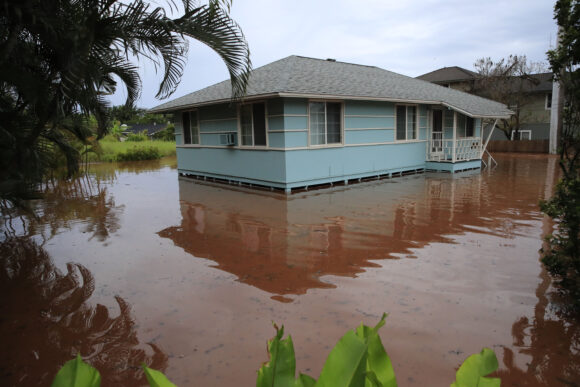HONOLULU (AP) — Heavy rains are part of the winter wet season in Hawaiian Islands. But the downpours triggering flooding that destroyed homes and bridges and set off mass evacuations on multiple islands this week are also an example of the more intense rainstorms officials and climate scientists say are occurring more frequently as the planet warms.
Two key ingredients came together in Hawaii in recent days to deliver the rain: an upper-level disturbance and extra moisture in the lower layers of the atmosphere. The downpours first affected Maui, moved northward up the island chain to Oahu and Kauai, then circled around and hit the southernmost part of the Big Island.
Meteorologists on Wednesday extended a flash flood watch for the entire state through Friday because of the potential for more rain and because the ground was already saturated.
The onslaught destroyed and heavily damaged two Maui bridges, along with at least six homes on the island.
The rain filled a 138-year-old reservoir once used to irrigate sugar plantation fields that has recently been kept empty as its owners prepare to dismantle it this summer. So much water accumulated it started overflowing from the 57-foot (17.4-meter) high structure at one point Monday, and county officials ordered people downstream to evacuate amid fears the earthen dam could breach. Ultimately, the reservoir didn’t fail, and water levels dropped as the rain let up.
The National Weather Service reported 13.2 inches (33.5 centimeters) fell over eight hours in the vicinity of the dam in Haiku on Maui’s north coast.
“This is really an example of climate change in the present day,” Suzanne Case, the head of the state agency that regulates the dam, the Department of Land and Natural Resources, said in a statement. “We have a flood emergency because of the heavy rain bomb. And we’re seeing these more and more across the island chain – more frequent and more extreme events.”
On Oahu, flooding covered roads and yards in towns on the eastern coast. Rising waters in the Opaelua Stream, which carries waters from the mountains down to the ocean, set off an evacuation order for the small town of Haleiwa, a mecca for big-wave surfers.
Honolulu firefighters on Tuesday rescued a 27-year-old man after his truck was swept down a stream. They found him standing on the truck’s roof. On Wednesday, they suspended another search for an individual a witness saw in a stream in Pearl City.
Overall, Hawaii has had less rain in recent decades and at times has been battling drought. Just Tuesday, the U.S. agriculture secretary approved a drought disaster declaration for parts of Maui County.
A 2010 report from the University of Hawaii’s Sea Grant College Program said rainfall declined 15% over the prior 20 years. Yet the same report said between 1958 and 2007, rain events with the heaviest downpours increased 12%, underscoring that more intense rainstorms are growing in number.
Pao-Shin Chu, a University of Hawaii professor and the state’s climatologist, said theoretical studies suggest that for every one-degree Celsius increase in sea surface temperatures, there is likely to be a 7% increase in atmospheric moisture.
Hawaii is experiencing some of this increased moisture already. In 2018, Kauai set a national record for the amount of rain recorded in a 24-hour period when 49.69 inches (1.26 meters) fell from April 14 to April 15. The same storm set off landslides and blocked the only highway connecting small Kauai north shore towns to the rest of the island.
The frequency of intense rains like that one and this week’s are an indication people should be prepared for such events more often, Chu said.
“Don’t think that this is like a once-in-a-hundred-years event that you’ll only see once in your lifetime. It is changing,” Chu said.
Less time is lapsing between them, he said. “So it could be once every 30 years. Who knows?” Chu said.
To better prepare for future disasters, he said it will be important for scientists to understand how weather was interacting with a warming climate to cause so much rain to fall in such a short period.
Honolulu Mayor Rick Blangiardi said the city will need to work with state partners to keep waterways clear of debris to help prevent flooding.
“We need to get used to climate events like this,” Blangiardi said. “A tremendous concentration of rain in a small amount of time in focused areas is going to result in flooding anywhere. If we have situations like that, then we need to really approach and attack.”
About the photo: A house on Haleiwa Road is surrounded by floodwaters Tuesday, March 9, 2021, in Haleiwa, Hawaii. Torrential rains have inundated parts of Hawaii for the past several days. (Jamm Aquino/Honolulu Star-Advertiser via AP)
Was this article valuable?
Here are more articles you may enjoy.


 First Brands Judge Approves Examiner to Probe Fraud Allegations
First Brands Judge Approves Examiner to Probe Fraud Allegations  Munich Re: Insured Losses From Wildfires, Storms and Floods Hit Record High
Munich Re: Insured Losses From Wildfires, Storms and Floods Hit Record High  OpenAI And Microsoft Sued Over Murder-Suicide Blamed on ChatGPT
OpenAI And Microsoft Sued Over Murder-Suicide Blamed on ChatGPT  Tesla, EEOC Plan Talks to Settle Factory Racism Suit
Tesla, EEOC Plan Talks to Settle Factory Racism Suit 